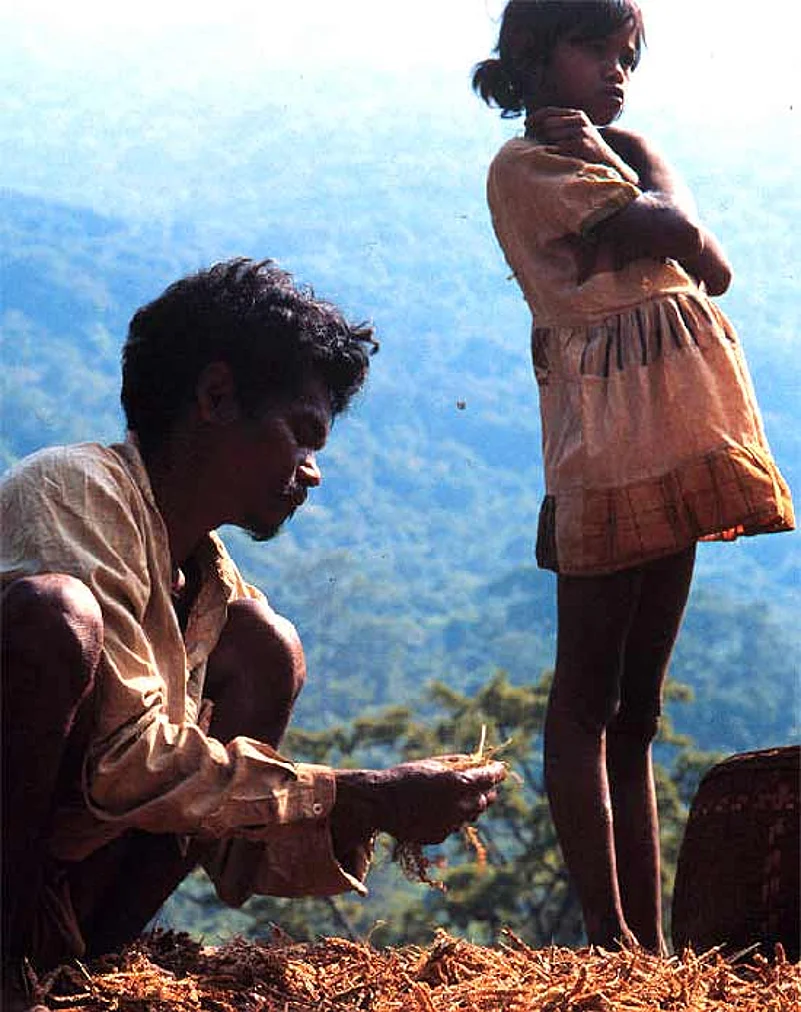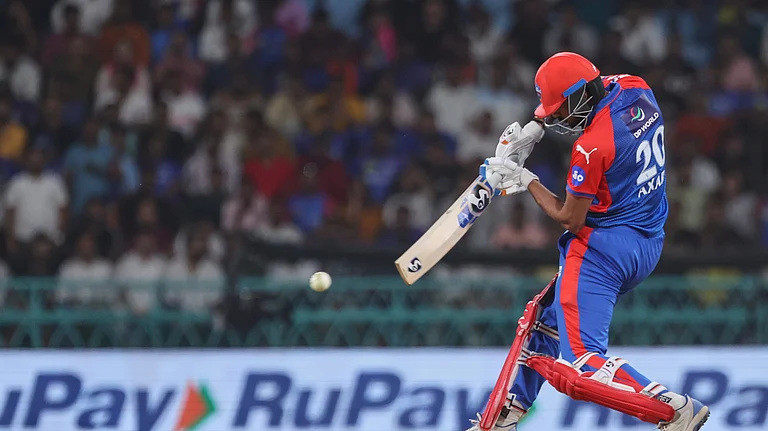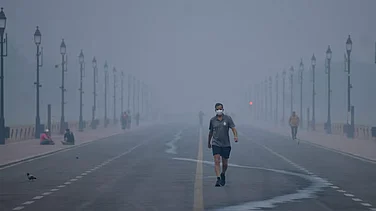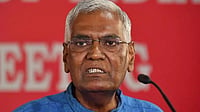This is where there is nothing. Except misery. Where life begins with the rude jolt of a scythe and ends in an extended orgy of suffering. Where the struggle for existence centres on cultivating a small patch of rocky land perched precariously on a hill-side to enable a family to survive for six months a year. And children are not named till they are nearly two years old because the mother never knows whether the baby will survive. Where a child's most productive years are between the ages of 8 and 13, ripe, yet pliable enough, to be sold to labour. And the unholy trinity of politician, administrator and planner form a vicious nexus. The long arm of the state does not extend here, though its accompanying paraphernalia does make a cosmetic appearance in parts and makes a mockery of the official poverty line, pegged at Rs 11,000 per annum. Hunger is the norm here and human dignity, intrinsically, is not an essential to life. This is Raigada, in the interiors of Orissa.
Rupiya Bhuiya's Story
It is 9 am and time for the first meal of the day— a small portion of gruel made of ragi (millet) boiled in water. Rupiya Bhuiya squats on his haunches outside his mud-and-thatch hut halfway up the mountain in the lower reaches of which his village— Bursunda (Koinpur)— nestles, and devours the reddish, watery paste that is his staple diet for six to eight months a year. He eats in fits and starts ; at times very slow and deliberate, as if to prolong the sensation of something substantial passing down his gullet. But often, he shovels the meagre victuals furiously into his mouth, for he has been at work on an empty stomach since 5 am.
What is unmistakable, however, is the satisfaction in his voice when he says that the gruel contains a pinch of salt, a luxury he can afford for a maximum of nine months of the year. But then, so is food. Today, though, Rupiya and his two children will eat in the evening too. "You have come at a good time," we are informed .
The "good time" lasts from August till January each year when Rupiya treks up to a patch of land (called the bogodo) high above his village, which he hopes will yield enough grain to feed his family for half the year, and makes his home there. It is subsistence agriculture in its most primitive form; he practises shifting cultivation, moving from one patch of land to the other every second year, planting the seeds left over from the year before. Then, he spends the next six months protecting the crop from wild boars, monkeys and birds. And praying that the weather will be clement.
Rupiya's wife died a few months after the birth of his youngest child, Sunari, who is now about nine years old. His son Jagannath, is 14 and another child, a girl, died at the age of 12 over eight years ago. All Rupiya can cite as the reasons for the deaths is that "they had fever and were hungry". "Earlier this year, when my stock of grain from the bogodo months ran out, I and my children survived on shalpa (the pith of the shalpa tree), wild mango seeds and khajuri (the local date brew) for nearly three months. The bogodo yielded about 30 kg of grain and that was enough, mixed with shalpa, to increase the quantity of gruel by boiling it in water, to last for a little over six months. We ate once a day towards the end of this period," he adds. Mahua liquor and anything even remotely edible that they could forage from the forest, are what father and children survived on for the rest of the year.
Rupiya's life also debunks some myths which have found their way into contemporary politico-economic discourse: that all tribals in forest areas can always take out their bow and arrow and go hunting. That they can never starve because there is 'always something' to eat in the jungles. And that roots, bark and ants are 'traditional tribal delicacies'. "I don't have a bow and arrow. Only a couple of people in the village do. I don't know how to hunt. Anyway, it is dangerous and one needs a full stomach to spend days chasing an animal," says Rupiya. His family survives on bark, not because it is a 'traditional delicacy' but because they have traditionally gone hungry.
This is an annual phenomenon. Their malnourished frames bear testimony and provide an insight into how the economy of survival works: months of intensive labour go into subsistence farming for food lasting six months. A couple of months of barter, if the harvest has been a particularly good one, in salt and pulses. Followed by a month or so of any odd job that comes Rupiya's way, such as scouring the hills for twigs and sticks used to make brooms.
Only a few of these means of survival are open to Rupiya each year though, and some years there are none. Then all roads lead to the moneylender, or sahukar. A small loan will mean repayment in grain the next year. And the cycle of desperation will intensify. "But the sahukar never asks me to put a thumb impression on a piece of paper. He trusts me because both my father and grandfather went to him too," says Rupiya proudly. "I had a deal with a man from another village that if I reared his goats, any of its kids would be shared equally among us but he reneged on his promise." His anxiety is understandable. It is the only hope Rupiya has of procuring any money if he or his children fall ill. Even a sickly goat would fetch upwards of Rs 200. But there is no guarantee that it would really help. To get from Bursunda to the nearest government dispensary in Koinpur involves a three-hour climb up a steep incline. And if someone is seriously ill, then it is another two-hour bus ride to the district hospital in Parlekhamundi. Finally, medicines have to be bought. In most cases, the seriously ill are left to die. Just as Rupiya's daughter was....
The children have seen the outside world just once; they accompanied Rupiya to Koinpur on one of his inf requent visits there. Sunari whispers that she saw a bus in Koinpur. Would she like a ride on it? A timid "no" is the response. "When it passed us on the road, there was a strong breeze which made me feel very cold. It will be worse inside the bus," she says.
As for their ragged clothing— it has come from the dead. Literally. "When someone dies in the bigger villages, their clothes are given away to the dhobi, who sells them to us for two to five rupees. I bought the clothes the three of us are wearing a few years ago," Rupiya mutters.
Doma And Sambari's Story

Doma and Sambari have been forced to sell their sons for Rs 700
Sambari has borne nine children in a marriage that is a little over 12 years old. Five of them are dead. She is seven months pregnant again. Of the four surviving children, both the boys have been sold to labour. Doma, their father, says it is only for a year. But then admits that it could be for longer. Much longer.
As the contours of the land change from Bursunda (Koinpur), in the higher reaches of the Eastern Ghats, to Sankuda, a relatively prosperous village in the foothills that flow into northern Andhra Pradesh, so do the shades of poverty.
Because, though poverty is the constant, here there are also those who are better off. And this fulfils the one pre - requisite for selling a child: a buyer. There are enough of them in neighbouring Andhra Pradesh, looking for cheap labour.
Two years ago, Doma and Sambari ran out of money. They had nothing to eat. Three of their children had already died of severe malnutrition and malignant afflictions ranging from malaria to meningitis. They had watched helplessly. Then, two more fell ill. So, Doma let out the one acre of very rocky land he possessed for a period of 10 years, in lieu of a payment of Rs 100 each year. But the family still did not have enough to eat. He bor rowed 'heavily'; all of Rs 500. But he could save neither of his children. Last year, he borrowed Rs 500 more. A major portion of that was spent on the rituals that the villagers egged him on to perform in memory of the two children who had died the year before.

In the summer of 1995, there was a diarrhoea epidemic in Sankuda. Both his surviving sons fell ill. Again, there was no grain to eat as he had let out his piece of land. And he was heavily in debt. "I sold my sons, Somnath, 10, and Hadiya, 8, to Gopi and Bhima, respectively, who own land across the border in Andhra Pradesh. They will pay me Rs 400 for Somnath and Rs 300 for Hadiya for a year.
Then I will renegotiate the price for the next year and so on each year for as long as it is necessary," says Doma.
If there ever was a classic debt trap, this is it. And there can be no doubt about the first cause— abject poverty. "It is not easy to sell one s child," he laments. "But my family would have died of hunger and disease if I had not sold my sons. Today, we manage to eat once or twice a day because of the Rs 300 (of the Rs 700 promised) which the owners of Somnath and Hadiya gave me before they took the children away. I have also taken 120 kg of jonna (a millet grain) on loan from five different sahukars for the year at an interest of 50 per cent, and I don't know how I am going to pay it back."
Doma, suffering from TB himself, refuses to say any more. But Sambari adds: "I have had so many children because I don't know how many of them will survive. Whenever any of us falls ill, and that is very often, death is the likely outcome. My children, even if I had fewer, would never have had enough to eat. And disease would have killed them anyway. We have no choice but to have as many children as possible and hope some will survive." The expression, safety in numbers, acquires a whole new meaning here .
The nearest government health facility for Sambari and her flock is the primary health centre at Gangabada, a 30-minute walk, which is perennially under-stocked and usually unmanned. The altern a tive, especially if it is a life-threatening ailment such as malaria or dengue fever which are widespread here, is the Parlekhamundi district hospital. It is a full day's journey, most of it on foot. And there a re the quacks and a few compounders in the small town of Mandasa in Andhra Pradesh, two hours away. But there is never enough money. And they can only look to the guniya ( witch - doctor) and the 'bulla doctor', or wandering quack (see box), for relief .
A one-and-a-half hour walk from Sankuda gets you across the Andhra border and into the village of Singpur. It is a relatively large village and it even has electricity. This is also where Somnath and Hadiya stay with their owners.
"Get up gandu (bugger)." This has been the wake-up call for Hadiya for the past six months. "It is still dark when my day begins. I untie the buffaloes and rub them down before going out to gather fodder. I get thrashed if I mess up any chore," he says in an undertone. He helps out in the fields, chops firewood, tends the cattle and is expected to perform any other task thrown his way.
Somnath, his body covered with sores that have never been treated, speaks very little. Except to say that he "does not like it here ". He cries a lot because he misses home, but knows that he has to stay with his owner. "I get to eat twice a day— rice left over from the previous day boiled in water. Sometimes, if some subzi (vegetable) is left over, I get that too. I also feel very cold at night," he adds. It is tempting to portray the owners, Bhima and Gopi (also brothers), as ogres who have robbed the boys of their childhood. But they are not particularly well-off themselves; they own just medium-sized holdings and can afford to pay only a little for agricultural and domestic help. As they see it, they are paying for a job and expect to see it done. And the treatment meted out to the children? "They are not ours," about sums up the attitude. It is all very matter of fact.
As is selling children for labour in these parts. In Akhada village, Arjuna and Raibari Sabar have sold their 10-year-old son Labada to a sahukar in Singpur because they could not repay their debt. And in Gangabada, Bhima Sabar is thinking of selling his three - year-old daughter as the last resort, if the moneylender comes calling. Children are 'sold' in this part of Raigada when they are between the ages of 8 and 13; they are not of much use as labour before attaining the age of 8, and most often, run away from both 'owner' and parents after they turn 13.
Domba and Alangi Sabar's Story
" Don't you cry, little one, don't you cry/Look at the monkey up to his tricks, hear the dog bark and the birds sing/Don't you cry little one, don't you cry."

The elder among Domba and Alangi Sabar's seven children take turns at singing this old Saura lullaby to their two-year-old sibling. But the song is not intended to put a cantankerous child to sleep; it is an attempt to soothe his emaciated body of the fever that rages within. In the absence of both the time and the means to provide him with any medical relief, this is the best they can do. He has probably contracted malaria— possibly the fatal cerebral strain which abounds here. Alangi seems to realise this. "I don't know whether he will live," she says.
The hut at their remote— even by Raigada standards— bogodo in Bursunda (Gangabada) has been built on a tiny clearing on a steep mountainside. There is barely enough room to stand when all nine of them are in it at the same time. "I can't take the child to Gangabada or Koinpur because that would mean being out for more than half the day, and the monkeys will ruin the entire crop within hours. And making the long journey to either Mandasa or Parlekhamundi is out of the question," Alangi says. That, in essence, is the problem, says a doctor attached to an NGO working in the area: "In the bogodo days, infant mortality is at its peak, while through the rest of the year, cases of severe malnutrition register a sharp rise because there is not enough food to eat."
" We survived because I had borrowed Rs 50 from a moneylender. N o w, I am worried about how I will pay it back," says Domba. After calculating the interest, the sahukar has told Domba that he will have to repay him with jonna worth Rs 105.
The abiding memory of this family remains that of a group of children with swollen bellies— their bodies covered with sores and boils. Time for one last photograph of all of them together, and one thought flits through the mind: that there are family pictures, and there are family pictures.
All of this in a country where "our culture", it is alleged, does not allow a fellow human being to starve? Where charity is supposedly ingrained in the collective consciousness of the masses? This all-pervading paralysis of thought and action is, in the deepest sense of the word, unacceptable.
Living Hand to Mouth

The staple diet from September to January
Breakfast : Between 8 and 9 am after having worked the fields for a few hours. Comprises a gruel pre-pared by boiling ragi (millet) in water with a pinch of salt. A plateful.
Lunch: None.
Dinner: Gruel again, with jonna (another millet grain) replacing the ragi. Barely a plateful.
In February, March, April and August
Breakfast : At around 11 am. Gruel made of ragi or jonna, depending on which grain is left over from the six months of shifting cultivation. A plateful.
Lunch: None.
Dinner: None.
The pith of the shalpa tree, wild mango seeds and the local brews made from the mahua flower or khajuri (dates), depending on availability, are the supplements.
In May, June and July
Breakfast : None.
Lunch : None.
Dinner : None.
Shalpa, wild mango seeds, wild roots, mahua, khajuri are eaten and drunk intermittently through the day. Living Hand to Mouth


























